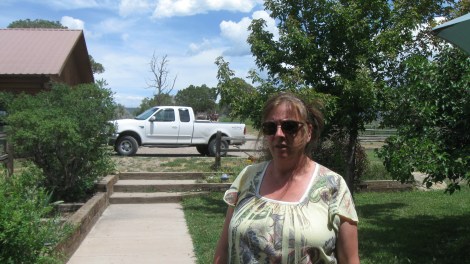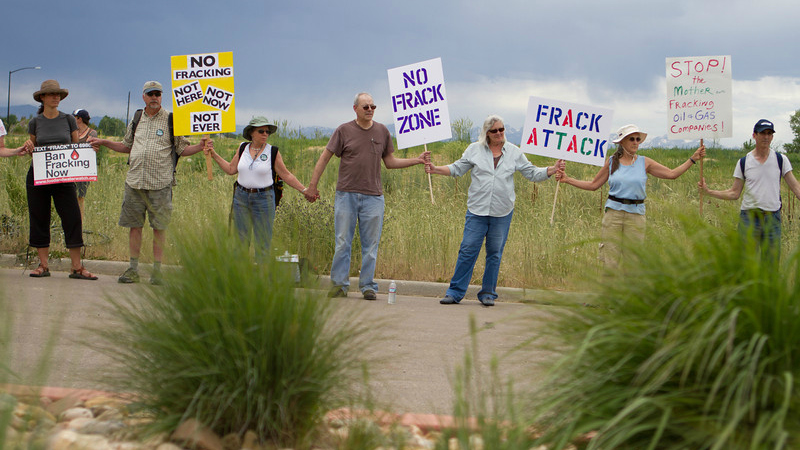Driving around the rural back roads of Garfield County, Colo., you don’t see many cars. But one type of vehicle keeps popping up, often the only one you’ll see for hours: the white pickup trucks favored by gas drilling companies. Here in the central western part of the state, the rolling fields of scrubby yellow-green vegetation are frequently punctuated by natural gas wells. Even after a well has stopped producing gas, big cylindrical tanks of waste water and natural gas condensate remain, sitting behind low fences by the roadside. Too often those tanks emit toxic substances into the air or leak their contents into the ground, including volatile organic compounds (VOCs) such as benzene and toluene.

Are these ones leaking?
People who live on or near properties with gas wells say they have experienced an array of health effects from exposure to high concentrations of these chemicals. The known immediate effects of exposure to high concentrations of benzene, according to the Centers for Disease Control, include headache and drowsiness. Long-term exposure can cause cancer, as well as fertility problems in women.
Karen Protz certainly thinks being surrounded by gas wells is at least partially responsible for her overwhelming health problems. In 2005, as the fracking boom brought gas wells closer to her log cabin on a winding mountain road, Protz began to feel sick. “I was walking five miles a day for three years to lose weight,” says Protz. “Then I started not feeling good: tired, lethargic. I’m Italian and I love to eat, and I couldn’t even look at pizza. I started having heart palpitations.”

Karen Protz
In the years since, her problems have multiplied and worsened. She gets frequent sinus infections, and has had several benign growths on her thyroid. More recently she has suffered from blood clots and a mild stroke for which her lab work can produce no explanation. Protz gets out of breath just from climbing a flight of stairs and is on oxygen at night, though she has never been a smoker. When she goes back to visit family in Delaware, or even just east to Denver, her symptoms subside. But they come back as soon as she returns home. She might move, but her husband works in the area and her grown children live here. Sitting in her living room, under the giant elk and deer heads over the fireplace, Protz tears up as she says, “I just wish I didn’t feel like I was 70 in a 53-year-old body.”
The gas companies note that no studies have demonstrated that their wells in the area are causing these problems. There’s a dearth of good data on how much VOCs people breathe in due to living near a well. “If people have health concerns we take that seriously, but we have seen no data that there is a direct cause or correlation between symptoms and our operations,” says Doug Hoch, a spokesman for Encana, one of the major gas production companies in the area. Protz and others who are sick counter that this is partly because the high concentrations of VOCs in the air are not being properly measured. Colorado has relatively stringent requirements for air quality reporting, but they rely on companies to do the reporting themselves. There is also the issue of access to the wells, which of course the gas companies do not grant to independent researchers. Nonetheless, a 2012 study by the University of Colorado-Denver School of Public Health found VOCs in Garfield County five times above the EPA’s Hazard Index level.
Toxic chemicals are not the only air pollutants created by gas and oil drilling. Greenhouse gases are also released, as are the gases that contribute to the formation of ozone, which causes breathing problems. A University of Colorado study from 2013 found that more than half of the ozone pollution in Colorado is caused by oil and gas drilling. Ozone levels in Colorado’s Front Range — the heavily populated spine where the Great Plains meet the Rocky Mountains — have risen in recent years and consistently exceed the levels deemed safe by the federal government.
Even if it doesn’t make you sick, living next to gas wells can be unpleasant. Residents say drilling makes the wells release a “rotten egg” or “chemical” smell. The gas and the fracking fluid can infiltrate your water supply. None of the residents of Garfield County whom I interviewed drink their tap water. Their dogs won’t drink it due to the smell. Protz and her family have even gotten rashes from using the shower. Protz also says her house has experienced earth tremors because of the seismic testing done by gas companies. “My sister came to visit from Delaware in 2007,” Protz recalls, “And she said, ‘How the hell do you live here?’”
The process of building and tapping gas wells is loud, and the floodlights involved can make it feel like your window looks out on airport tarmac. These activities often go on in the middle of the night, making a good night’s sleep impossible. (Critics assert that the gas companies deliberately work at night to avoid detection for violations by state authorities, since the inspectors only come during business hours.)
All these annoyances may adversely affect property values. Mike Smith owns a small horse ranch and heating/air-conditioning business in Rifle, Colo. Across the two-lane road from him is a welcome sign over a neighbor’s driveway reading “My Heaven.” And just a few feet over from that, straight across the road from Smith’s front door, is a gas well owned by the Bill Barrett Corporation, an oil and gas exploration firm based in Denver. Barrett chose to put the wells right next to the road. Smith claims they did this as retribution for his refusal to agree to let them drill on his property. “They told me it was because I’m ‘uncooperative,’” he says. The smells from fracking are so nasty, Smith recalls, that a friend who was helping him put up a fence in his yard vomited. Smith estimates that his land and house have lost about a third of their value due to drilling. (Barrett did not return a request for comment.)

The view from Mike Smith’s house.
The truck traffic to build and service the wells is another sore point for locals. It interferes with the serenity for which they moved there. One encounters signs with phrases such as “Private Road: No Encana traffic.” And the truck traffic can be worse than merely annoying. A truck carrying fracking fluid flipped over right at the end of Protz’s driveway, spilling the chemicals. The cleanup lasted four months. “It was like something from a space movie, with the white suits,” says Protz.
Encana says it’s doing what it can to improve its processes. “We understand there are some folks that are not in favor of oil and gas development in the area,” says Hoch, “but we certainly work to minimize the impact.” The company has started piping water to wells to reduce truck traffic, he says.
Many of the problems neighbors complain about would violate state law, but they don’t get officially reported or verified by inspectors. If you call to report a foul odor, especially on a night or weekend, a state worker will come several days later to test the air quality and often find no problem. And even when violations are noted by the state, the penalties are too small and infrequently imposed, environmental activists say. “Fines are cheaper than doing it properly,” says Tara Meixsell, a local anti-drilling activist and author. The Colorado Oil and Gas Conservation Commission, which is responsible for enforcement, is underfunded and incapable of inspecting every well. In 2011, there were 516 known spills but only five assessed fines.
In an interview with Grist at the Aspen Ideas Festival in June, Gov. John Hickenlooper (D) noted that he has doubled the number of oil and gas inspectors in the state. That’s roughly true — the number has risen from 15 in 2011 to 27 in 2013 — but considering that there are about 50,000 active oil and gas wells in Colorado, that’s not very impressive. “We’re trying to get a gauge at every wellhead and measure benzene,” he added. Hickenlooper also boasts that his administration earlier this year adopted some of the nation’s strictest rules governing VOC and methane emissions at drilling sites. (Methane is a potent greenhouse gas, and methane leakage may wipe out the climate change benefits of natural gas over coal.) Environmentalists, though, argue that the new rules are not strong enough to achieve reductions in total pollution when 2,000 new wells are being drilled in Colorado every year.
In Colorado, as in many other Western states, there’s a “split estate” approach to land ownership, which means that mineral rights beneath the surface are often bought and sold separately from the surface of the land itself. So people who live on the land can be forced to endure the adverse effects of drilling by the owners of the ground underneath. The divided incentives have had a predictable effect on communities in Colorado, pitting neighbor against neighbor.
Hickenlooper argues that it wouldn’t be fair to the mineral rights owners to let the residents vote to ban fracking. “Owners of mineral rights have a right to their property,” he says. “Both sides have a legitimate right.”
And that’s why neither side will give up easily. With state initiatives to limit fracking likely to appear on Colorado ballots this fall, the battle will only get uglier.



